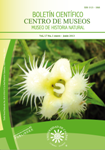Authors
Abstract
Nematodes are part of the soil food webs with decomposers, micophages, bacteriophages, predators and plant parasitic; when there are disturbance and pollution of soil affect the same populations of these trophic groups, which are used to assess the health and quality of ecosystems. The goal of this research was to identify and create a photographic record of the nematode communities inhabiting forest and bamboo ecosystems in the Montelindo farm of the Universidad de Caldas. In these ecosystems, root and soil samples were collected using GPS receiving equipment, allowing to generate a grid of georeferenced sampling taking samples every 15m. Later, in the laboratory of Plant Pathology at the same university was nematodes extracted by centrifugation and flotation in sugar method. The ecosystem of bamboo had the most high biodiversity with nematodes fauna, and there were identified as 29 genera of nematodes of the Secernentea class, located in Aphelenchida, Monhysterida, Rhabditida and Tylenchida orders, and Adenophorea class, located in Araeolaimida, Dorylaimida and Triplonchida orders; likewise in the forest ecosystem found 26 genera of nematodes, mostly belonging to the Secernentea class, located in Aphelenchida, Rhabditida and Tylenchida orders, and to a lesser proportion in class Adenophorea located in the Chromadorida, Dorylaimida and Triplonchida orders. The trophic group with 46% of plant parasitic nematodes predominated in both ecosystems, followed by bacteriophage, micophage and predatory with 40%, 13% and 1.5% respectively, showing that these ecosystems are rich in diversity of nematodes fauna.
References
AZPILICUETA, C.V.; ARUANI, M.C.; REEB, P.D. & SÁNCHEZ, E.E., 2008. Estructra de la commnidad de nematodes del suelo bajo dos niveles de ferililzacion nitrogenada en Alto Valle del Río Negro Argentina. Nematropica 38:75-86.
BONGERS, T., 1999. The maturity index, the evolution of nematode life history traits, adaptive radiation and c-p scaling. Kluwer academic publishers. Plan and soil 212: 13-22.
BONGERS, T. & FERRIS H., 2009. Indices developed specifically for analysis of nematode assemblages Capitulo en: CAB International 2009. Nematodes as environmental indicators (eds M.J. Wilson y T. Kakouuli-Duarte).
CASTAÑO, J.H. & CORRALES, J.D., 2010. Mamíferos de la Cuenca del río la miel (Caldas): diversidad y uso cultural. Bol.cient.mus.hist.nat. 14 (1): 56-75
CASTILLO, P. & VOVLAS, N., 2008. Pratylenchus (Nematoda, Pratylenchidae): Diagnosis, biology, pathogenicity and management. Nematology Monographs and perspectives. Brill Academic publishers. 529 p.
EYUALEM-ABEBE A.I. & TRAUNSPURGER, W., 2006. Freshwater nematodes: Ecology and taxonomy. CAB International.
FERRIS H.; BONGERS, T. & DE GOEDE R. G.M., 2001. A framework for soil food web diagnostics: extension of the nematode faunal analysis concept. Aplied soil ecology 18: 13-29.
FRECKMAN, D.W.; MANKAU, R. & FERRIS, H., 1975. Nematode Community structure in desert soils: nematode recovery. Journal of Nematology 7 (4): 343-346.
GIRALDO, E., 2009. Bienes y servicios ambientales de la guadua en Colombia (Guadua angustifolia Kunth). En: http://www.sigguadua.gov.co/index.php?option=com_docman&task=doc_details&gid=9&Itemid=37
GOMEZ, S.; MERCADO, J.; PAYARES, F. & PEREZ, C., 2010. Identification de nematodos asociados al pasto colosuana (Bothriochloa pertusa (L) A. Camus) en el municipio de Sampues, Departamento de Sucre, Colombia. Rev. Colombiana Cienc. Anim. 2 (2). 2010.
HUNT, D.J., 1993. Aphelnchida, longidoridae and trichodoridae: Their systematics and bionomics. Wallingford, UK, CAB Internationa. 352 p.
LEGUÍZAMO, M.C. & PARADA, J.C., 2008. Nematodos del suelo en el sistema maíz-soya y en habitats naturales adyacentes de la Altillanura colombiana (Meta). Revista Corpoica – Ciencia y tecnologia agropecuaria (2008) 9(1), 61-65.
HUNT, D.J.; LUC, M. & MANZANILLA, R.H., 2005. Morphology, anatomy and biology of plant parasitic nematodes – a sinopsis. En: Plant Parasitic Nematodes in Subtropical and Tropical Agriculture. Edited by Luc M. & Sikora. CAB International. Londres. pp.11-52.
MAGGENTI, A.R.; LUC, M.; RASKI, D.J.; FORTUNER, R. & GERAERT, E., 1987. A reappraisal of Tylenchina (Nemata). Revue Nematol 10.
MAI, W.; MULLIN, P. & LYON, H.H. & LOEFFLER, K., 1996. Plant parasitic nematodes. A pictorical key to genera. Fifth edition. Comstock Publishing Associates. A division of Cornell University Press. 277 p.
MEREDITH, J., 1973. Algunos métodos de campo y laboratorio para trabajar con nematodos, Maracaibo, Venezuela. 44p.
MONTOYA, S.; GALLEGO, J.H.; SUCERQUIA, A.; PELÁEZ, B.J.; BETANCOURT, O. & ARIAS, D.F., 2010. Macromycetos observados en bosques del departamento de caldas: su influencia en el equilibrio y la conservación de la biodiversidad. Bol.cient.mus.hist.nat. 14 (2): 57-73.
MORENO, C.E., 2001. Métodos para medir la biodiversidad. M&T-Manuales y Tesis SEA, vol.1. Zaragoza, 84 pp.
NGUYEN, K.B., 2011. Clave Rhabditida: Rhabditina (2003). En: http://www.kdnguyen.ifas.edu; Consulta: Julio de 2011.
OSPINA, R. & RODRIGUEZ, J.M., 2002. Biodiversidad en guaduales, importancia e implicaciones para un buen manejo. Seminario Taller Avances en la investigación sobre Guadua.
PANESAR, T.S & MARSHALL, V.G., 2001. Monograph of soil nematodes from coastal Douglas-fir forests in British Columbia. Part of the final report submitted to FRBC/ SCBC (Forest renewal British Columbia/ Science Council of British Columbia) 110p.
PERRY, R. & MOENS, M., 2006. Plant nematology. CAB International. London. 447 p.
PERRY, R.; MOENS, M. & STARR, J., 2009. Root Knot nematodes. CAB International. London. 480 p.
RIOS, C., 2007. Riqueza de species de mariposas (Hesperioidea y Papilionoidea) de la quebrada "el aguila" cordillera central (Manizales, Colombia). Bol.cient.mus.hist.nat. Vol 11 : 272-291.
ROJAS, W.; ESTÉVEZ, V. & RONCANCIO, N., 2008. Estructura y composicion floristica de remanentes de bosque húmedo tropical en el oriente de Caldas, Colombia. Bol.cient.mus.hist.nat. Vol 12 : 24-37.
SIDDIQI, M.R., 2000. Tylenchida: parasites of plant and insects. CABI Publishing Eds., London. 800p.
TARJAN, A.C. & KEPPNER, E.J., 1989. Ploughing of a perennial grass lay-effect on the nematode fauna. Pedobiologia 33: 199-210.
THORNE, G., 1961. Pinciples of nematology. USA. McGraw-Hill – Book Company. 547 p.

 PDF (Español)
PDF (Español)
 FLIP
FLIP


















